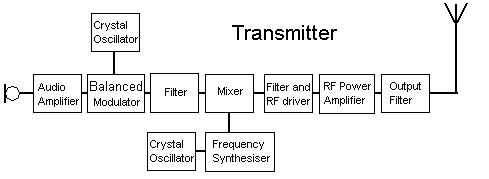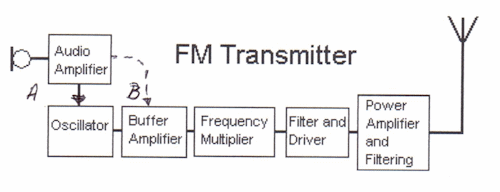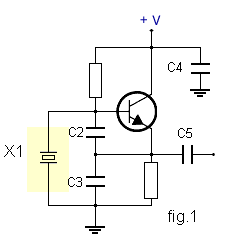

3A2 Recall the meaning of Modulation Index and its effects on the number of FM sidebands
The modulation index (or modulation depth) of a modulation scheme describes by how much the modulated variable of the carrier signal varies around its unmodulated level.
Put it another way FM Modulation Index is defined as the ratio of Frequency Deviation to the Modulating Frequency
FM modulation Index = Frequency of Deviation / Modulating Frequency
or put another way : mf = FΔ /
fm
Note that the carrier Frequency is not mentioned and this means that the Modulation Index is totally independent of the carrier Frequency.
The modulation of any carrier in any way produces sidebands. The FM sidebands are dependent on both the level of deviation and the frequency of the modulation. In fact the total spectrum for a frequency modulated signal consists of the carrier plus an infinite number of sidebands spreading out on either side of the carrier at integral multiples of the modulating frequency.
As the level of the modulation index is increased the level of sidebands increases in level.
e.g. A broadcast station has a deviation of 75KHz, and its modulation frequency is 15KHz, then its modulation index is 75/15 = 5. This is a large deviation. A modulation index of 1 means that the frequency deviation is equal to the modulating frequency, while a modulation index greater than 1 indicates more significant deviation.
More on this later in the course.
3B1 Understand the block diagram of an s.s.b transmitter employing mixers to generate the final frequency.

Fig. 1
Note: The diagram shows the Balanced Modulator and the Filter as two separate items but sometimes they are combined into a Balanced Modulator with Filter in one block.
A General Overview
When considering a transmitter it is probably best to think what it is trying to do. So what is it trying to do ?
Create an RF signal inside the amateur band
For the signal to be nice and clean
For the signal to be stable
For the signal to have minimum band width for the type of transmission
For the signal to have the correct power output
For the transmitter to have minimum output on other frequencies
Understand the block diagram of an FM transmitter employing either frequency multipliers or mixers to generate the final frequency.

Fig. 2
Note A In the diagram the Microphone feeds the Audio Amplifier which then feeds the Oscillator resulting with Frequency Modulation - RF now goes into the buffer amplifier.
Note B In the diagram an alternative is for the Audio Amplifier to feed Phase Modulation directly to the Buffer Amplifier. Phase modulation works by modulating, or changing the rate at which the radio frequency sine wave in the oscillator moves relative to an unmodulated wave.
Frequency multipliers
This FM version is using frequency multipliers. The Audio signal is acting directly onto the frequency oscillator which then passes the signal to a buffer amplifier to make it suitable to go into the frequency multiplier stage. When is has been multiplied up sufficiently to the output frequency it is filtered and the driver prepares the correct level of signal for the RF amplifier, which is followed by filtering to present the signal to the aerial.
However this arrangement has for the most part been overtaken by the general transmitter diagram fig 1 which can also be used for FM - when suitable modulators are employed.
So what else is there to know ?
This general over view, above, has shown you what happens to the signal from mic to aerial. The other sections, which follow below will give a more detailed account as to the activity of individual parts.

Fig. 1
3C1 Recall the effect and importance of minimising drift.
In Amateur Radio frequency drift is the unintended and generally arbitrary offset of an oscillator from its nominal… With somewhat older radios 1970's to the hybrids of the mid 80's seem to drift sightly or be off frequency slightly.
The most important aspect of drift would be to drift outside the prescribed band edges and thus interfere with other spectrum users.
When any piece of equipment, using an oscillator warms up, the frequency of oscillation changes. In the design stage of the equipment such variation will have been taken into account.
Should the frequency change after the warm up period then the effect of the change in frequency is called "drift".
You can sometime hear this drift of signals on the HF bands when older equipment is being used and to keep track of the frequency you would need to re-tune using the RIT. Then if you were to work the station your TX would go out on the original frequency and you would be Receiving on different frequencies as controlled by the RIT. (Receiver Incremental Tuning control)
Should you own old equipment then you must keep the amount of the "drift" to a minimum less than 3kHz else you could move in frequency out of the pass band of the station that is tuned to your signal. This drift would cause interference to other stations using nearby frequencies and could result in out of band transmissions - hence the reason to minimize drift.
There could be calculations in relation to this question such as how much drift could be allowed to occur before reaching a band edge. Drift is considered in ppm which is Part Per Million. So at 145MHz a drift of 40 ppm would be 145 x 40 = 5800Hz or 5.8kHz so with the band edge at 146MHz you could only go up to 146,000,000 - 5,800 = 145.994MHz. (This year 2024 we have a larger 2 metres band going up to 148MHz)
Understanding ppm and that MHz is a million Hz make the calculation quite easy when you bring everything to Hz and then convert back to MHz etc
Crystal Oscillator
The start of this process is with the crystal oscillators. These have to create :-
Stable
Accurate
Known
frequency suitable for the part of the circuit in which they are employed.
3C1 Recall the effect and the importance of minimising drift.
The reason for the stability is so that they do not "drift" off frequency and possibly put the transmissions outside the amateur bands but almost certainly a drift in frequency would take you into another QSO!! (Drift is a slight and gradual, yet unwanted change or frequency.)
The reason for the accuracy is that you must know for absolute certainty that you are inside the amateur bands. It is desirable to ensure that you use the appropriate frequency for the mode you are using - SSB, FM, CW or data ETC.
There are several ways to achieve the above:-
Crystal oscillator
The old way was to use a crystal oscillator and to change the crystal to change frequency, very stable and the frequencies are accurately known but limited to the number of crystals you have and they were and still are expensive!
Variable Frequency Oscillator
Another old way was to use a VARIABLE Frequency Oscillator. This gave you an infinite number of frequencies in a section of the amateur band.
Changing bands involved using a harmonic (multiple) of the same oscillator and retuning later stages of the transmitter to suit. The draw back was that such units were affected by heat, impact, when, say, you tapped your rig (microphonics) and thus did drift off frequency, and could give additional modulation to the wanted mode.
Frequency synthesiser
The modern way is to use a crystal oscillator which gives a stable frequency and link this to a frequency synthesiser which then gives you an accurate range of frequencies.
In all the methods mentioned above a stable voltage is needed which is in addition to the voltage power source for the power amplifier -again this is to ensure stability.
The synthesiser has two variants the PLL or Phase Locked Loop and the DDS or Direct Digital Synthesis (the DDS is not covered here as not part of the syllabus).
HOWEVER, there is one draw back in using a synthesiser rather than a crystal oscillator or VFO and that is what is called "noise level" - this is the back ground level of noise present in higher quantities than crystal or VFO oscillators.
WHY 2 Crystal oscillators?
These are in two different parts of the circuits and thus are performing quite separate operations (Note: some designs can use more than two crystal oscillators).
So what happens from microphone to aerial ?
The audio amplifier is linked to the modulator. Once the appropriate modulation has been applied, we now have a modulated signal which may be appropriately filtered but it is not on the correct frequency. This signal is then mixed with the output from the synthesiser to produce the desired output frequency, this then passes into the RF power amplifier and then is filtered again before it goes into the aerial.
So the transmitter has achieved:-
Create an RF signal inside the amateur band - All oscillators correctly chosen and working properly.
For the signal to be nice and clean - Appropriate design and filtering.
For the signal to be stable - crystal oscillator.
For the signal to have minimum band width for the type of transmission - filters and the use of linear amplification for SSB or other amplitude modulation modes.
For the signal to have the correct power output - correct use of RF power amplifier
for the signal to have minimum output on other frequencies - Band pass and harmonic filtering.
Get to know the function of the components in typical VFO and crystal oscillators.
the crystal oscillator

the variable oscillator

The oscillators shown above in figs 1 & 2 are very similar. In effect, fig 1 shows a crystal oscillator, with the transistor being used as an amplifier with POSITIVE feedback (provided by C2 and C3) at one particular frequency (determined by the frequency for which the crystal has been cut). In Fig 2, the crystal has been replaced with a parallel tuned circuit (consisting of the inductor L1 and C1). This achieves exactly the same result, giving the advantage that either the capacitor or the inductor value may be varied to achieve a change in frequency.
The crystal has a much higher "Q" value than the tuned circuit, and as a result, although the crystal frequency cannot practically be changed, it has the advantage that the output is very stable, being only slightly affected by changes in temperature etc.
Note the use of C6 in the variable oscillator. The function of this is to couple the tuned circuit to the transistor, whilst preventing the DC voltage on the base of the transistor being short circuited through the inductor. (The crystal does not pass DC, and hence this capacitor is not required in the crystal oscillator).
C4 is provided to ensure that:-
Any signals appearing on the voltage supply line do not get into the oscillator as they will safely pass to earth through the capacitor.
C4 also ensures that signals generated by the oscillator do not get onto the voltage supply line.
C5 couples the oscillator output signal to the next stage, whilst preventing the DC voltage on the emitter of the transistor being passed onward as well.
The resistors in the circuits are used to set the DC operation of the transistor. (i.e. biasing the transistor for use as an amplifier).
The origin of some of the text on this page is from the RSGB with additions by the web master
To Transmitters and Receivers menu